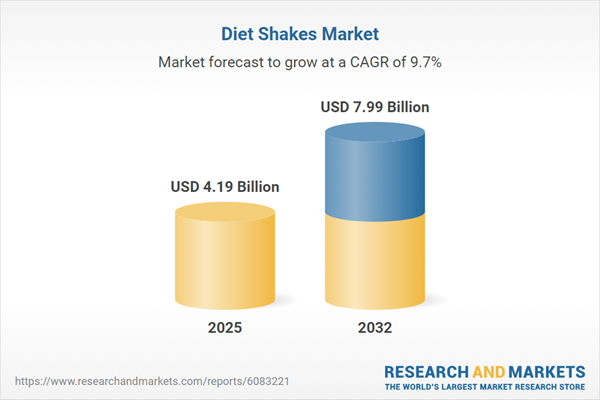Speak directly to the analyst to clarify any post sales queries you may have.
The diet shakes market is experiencing fast-paced evolution as health-conscious consumers prioritize convenience and nutrition, pushing organizations to recalibrate their strategies for innovation, sustainability, and channel expansion. This report offers concise, actionable market intelligence tailored for senior decision-makers seeking to align business objectives with shifting industry trends.
Market Snapshot: Diet Shakes Market Growth and Outlook
The diet shakes market progressed from USD 3.82 billion in 2024 to USD 4.19 billion in 2025 and is forecasted to reach USD 7.99 billion by 2032, supported by a projected CAGR of 9.66%. This growth is propelled by increased health awareness, advancing demand for functional and meal replacement shakes, and evolving consumer lifestyles. Industry leaders are responding to regulatory changes, fast-paced product cycles, and ongoing shifts from brick-and-mortar to digital retail channels by refining portfolios and expanding their go-to-market strategies.
Scope & Segmentation in the Diet Shakes Market
- Product Types: Covers low-calorie diet shakes for calorie management, ready-to-drink and powdered meal replacements, as well as protein shakes with both whey-based and plant-based blends to serve broad dietary preferences.
- Distribution Channels: Encompasses online sales through brand websites and e-commerce platforms, specialty retailers such as nutrition and pharmacy outlets, and mass market options including supermarkets and hypermarkets, facilitating diverse consumer access points.
- Packaging Formats: Includes glass and plastic bottles, aluminum cans, and flexible multi-serve or single-serve pouches designed to support sustainability initiatives and adapt to different consumption occasions.
- Key Ingredients: Features significant use of pea protein isolates or native forms, soy protein varieties, and whey protein in various concentrates to address changing protein sourcing trends and consumer demand for clean labels.
- Flavor Profiles: Offers chocolate, strawberry, and vanilla as leading flavors, influencing consumer repeat purchase, with opportunities for customized regional flavor additions.
- End User Age Groups: Addresses adults seeking balanced nutrition, elderly populations focusing on wellness, and teenagers looking for supplemental nourishment, extending product relevance across age demographics.
- Regional Coverage: Targets the Americas, Europe, Middle East and Africa, and Asia-Pacific—including countries like the United States, Canada, key South American economies, Western and emerging EMEA nations, China, India, Japan, and growing Southeast Asian markets—reflecting the sector’s global reach and regional adaption needs.
Key Takeaways for Diet Shakes Market Strategy
- Diet shakes are becoming integral to daily dietary routines, with rising adoption among consumers focused on weight management, wellness, and fitness recovery objectives.
- Ingredient innovation is enabling higher personalization in product offerings, empowering brands to engage consumers with tailored nutrition and delivery flexibility.
- Direct-to-consumer business models and the credibility of academic or validated product claims are increasingly shaping competitive landscapes and purchase decisions.
- There is mounting demand for sustainability, prompting companies to develop traceable supply chains and recyclable packaging that supports legislative compliance and customer retention.
- Localized product design—including regional flavors and formulations—is enabling brands to gain a stronger foothold and drive growth across diverse global markets.
Tariff Impact on Supply Chains and Pricing
Recent tariffs in the United States on key shake ingredients and packaging materials have altered established supply chains in the diet shakes market. Manufacturers are addressing these shifts by diversifying supplier bases, revising agreements, and increasing domestic investments to mitigate compliance and input cost risks. These adjustments demand more agile capital deployment and pricing strategies to maintain supply resilience.
Methodology & Data Sources
This diet shakes market analysis utilizes a mixed-methods approach, integrating insights from interviews with R&D and supply chain professionals alongside large-scale consumer surveys. Complementary secondary research—including regulatory filings and market publications—delivers a multi-perspective view of industry trends and operational dynamics.
Why This Report Matters
- Equips executive teams with data-driven insights to benchmark innovation initiatives and refine operational best practices within a competitive market environment.
- Supports strategic investment, expansion, and sustainability decision-making in response to dynamic regulatory and consumer drivers.
- Provides actionable guidance on navigating digital transformation and forging responsive supplier relationships for long-term business planning.
Conclusion
As technology, sustainability priorities, and consumer expectations evolve, companies that act on timely, comprehensive market data are better positioned to secure long-term performance in the diet shakes sector.
Table of Contents
3. Executive Summary
4. Market Overview
7. Cumulative Impact of Artificial Intelligence 2025
Companies Mentioned
The companies profiled in this Diet Shakes market report include:- Kellanova, LLC
- Nestlé S.A.
- Herbalife Nutrition Ltd.
- Medifast, Inc.
- Abbott Laboratories
- WW International, Inc.
- The Simply Good Foods Company
- USANA Health Sciences, Inc.
- The Beachbody Company, Inc.
- Glanbia plc
Table Information
| Report Attribute | Details |
|---|---|
| No. of Pages | 189 |
| Published | October 2025 |
| Forecast Period | 2025 - 2032 |
| Estimated Market Value ( USD | $ 4.19 Billion |
| Forecasted Market Value ( USD | $ 7.99 Billion |
| Compound Annual Growth Rate | 9.6% |
| Regions Covered | Global |
| No. of Companies Mentioned | 11 |









